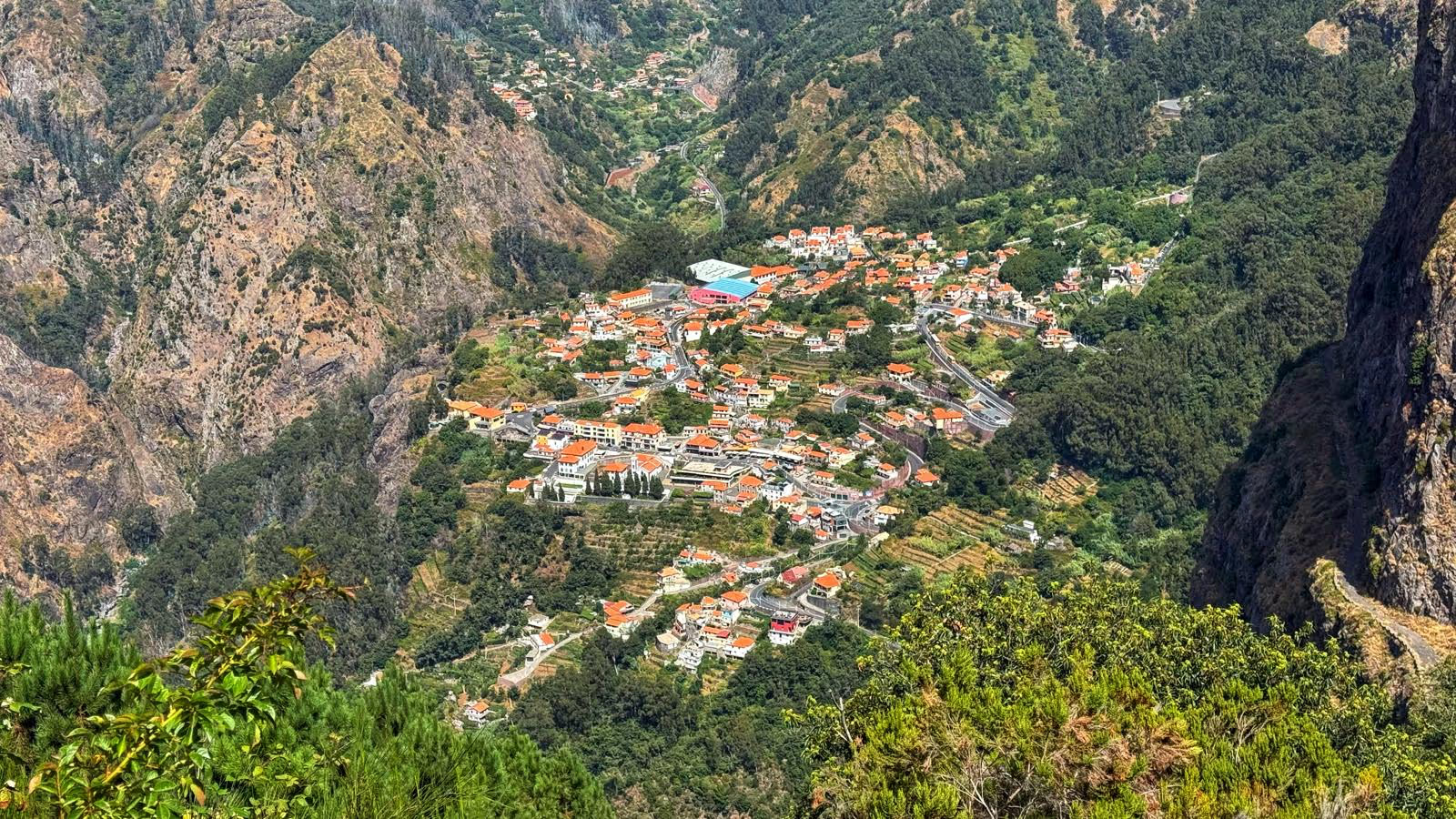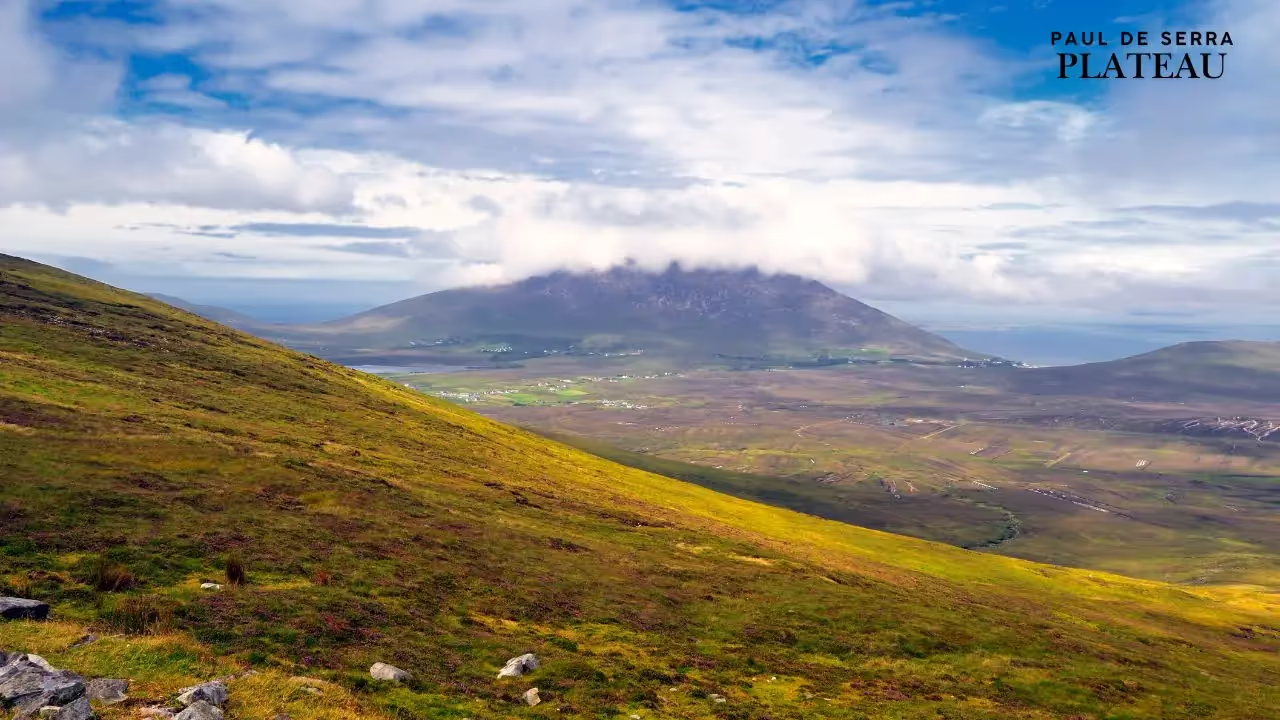Nuns’ Valley Unmasked: A Journey through Curral das Freiras’s History and Geology
Nuns, Nuts, and Not-Quite-A-Volcano: Unpeeling the Secrets of Madeira’s Hidden Valley.

Good To Know
Introduction – Setting the Stage (and Peeling the Banana)
Imagine standing on a mountain ledge with a warm Atlantic breeze ruffling your hair while your eyes scan an amphitheatre of sheer cliffs plunging down into a village so secluded that even pirates and time had trouble finding it. That amphitheatre is Curral das Freiras, better known to visitors as Nuns’ Valley. Hidden in Madeira’s interior, this tiny parish sits inside what looks like a colossal cauldron — some say a volcano’s mouth; others insist erosion carved it. For centuries it was a refuge for nuns, runaway slaves, shepherds and, in modern times, bus‑loads of selfie‑toting tourists. And yes, chestnut cake plays a starring role.
This article takes you on a 5 000‑word journey through Nuns’ Valley’s geology and human history. Like any good Madeira banana, it peels back layers: the ancient volcanic origins of the island, the debate about whether this valley is a collapsed caldera or simply the result of erosion, the legends of pirate attacks and nuns fleeing with treasure, the arrival of settlers and shepherds, the isolation that shaped local culture, and the modern challenges and charms. You’ll find factual information supported by citations from reputable sources and enough witty asides to keep even the most jaded tour guide smiling.
Madeira’s Volcanic Birth and the Valley’s Geography
A Hot‑Spot Island
Madeira sits on the African Plate about 700 km from mainland Portugal. The archipelago is part of Macaronesia — a chain of volcanic islands created by a mantle hot spot. Repeated volcanic eruptions built a huge mountain mass whose top fourth now protrudes above the Atlantic. Over time the island went through multiple volcanic phases: the oldest erupted around 18 million years ago and lasted until roughly 3 million years ago. Later eruptive phases enlarged the island with lava flows and pyroclastic deposits. The last recorded volcanic activity occurred approximately 6 450 years ago.
Understanding “Calderas” and Erosion
Volcanic activity can leave behind calderas — large depressions formed after the collapse of a magma chamber. However, not every bowl‑shaped valley is a caldera. Erosion, especially by rivers and landslides, can carve deep basins in volcanic rock. When you stand at the Eira do Serrado viewpoint and look down at Nuns’ Valley, it’s easy to imagine that an ancient volcano exploded here. This impression has fuelled myths and tourist brochures for decades. But geologists and local historians point out that the valley’s shape was largely sculpted by the Ribeira dos Socorridos and its tributaries. The cliffs you see are part of a volcanic cirque — a collapsed section of pyroclastic layers — deeply incised by streams and landslides over millions of years.
Multiple sources confirm that both volcanic processes and erosion contributed. A travel guide produced by the “Madeira‑by‑Bus” project notes that the valley formed over millions of years from volcanic activity and countless natural events such as water erosion, landslides and rockfalls. Likewise, the AllOut Travel blog, referencing geological information, describes the valley’s “vertical slopes … carved by millennia of volcanic activity and erosion”l. At the same time, older descriptions emphasise that what looks like a caldera is actually a depression carved by streams; the Via Gallica guide states that although people long mistook it for the bottom of a volcanic crater, the valley was dug by the Ribeira dos Socorridos. The Madeira Web site reflects the continuing debate, noting that the cauldron was either formed by erosion (the more recent theory) or by volcanic activity (the older belief).
So, is Nuns’ Valley a volcano crater? The answer is “yes and no.” Madeira itself is volcanic, and the rocks here are volcanic in origin. But the bowl shape that traps this village resulted largely from erosion and landslides acting on those volcanic rocks. In other words, the caldera story contains a kernel of truth, but the real sculptor was water and gravity.
Topography and Climate
The parish of Curral das Freiras covers about 25.07 km² and lies roughly 600 m above sea level in the municipality of Câmara de Lobos. Surrounded by sharp peaks — Pico Ruivo (1 862 m) to the northeast, Pico Grande (1 654 m) to the west and Pico do Serrado (1 115 m) immediately above — the valley’s slopes are almost perpendicular. This geographic isolation sheltered the community from outside eyes, a fact that would later prove crucial when pirates attacked the coast. The official Madeira Promotion Bureau describes Curral das Freiras as “located in a deep valley resembling a volcano crater” and notes that it sits hidden between mountains and is not visible from the sea.
Because the valley is so enclosed, it experiences a micro‑climate. Summers are warm, winters can be surprisingly chilly, and sudden fog is common. The steep slopes catch abundant rainfall, feeding numerous springs and creating fertile soils ideal for chestnut trees and terraced fields. The isolation also meant that until recently, roads and power lines were scarce; the village stayed rural long after coastal Madeira modernised.
Early Inhabitants: Shepherds, Slaves and Settlers
From “Curral da Serra” to a Gifted Dowry
In the 15th century, shortly after the Portuguese colonised Madeira, explorers and settlers began venturing into the island’s interior. The valley we now call Curral das Freiras was originally known as Curral da Serra (Mountain Corral) or simply Curral, reflecting its use as pastureland for cattle and goats. According to the tourism company Tukway Madeira, the valley initially belonged to the noble explorer João Gonçalves Zarco, who granted the lands for cultivation to João Ferreira and his wife Branca Dias. In 1474 the property passed to their granddaughter Branca Teixeirat, and in 1480 it was sold to Captain João Gonçalves Câmara, son of Zarco.
Captain Câmara later gave the lands to his daughters Joana and Elvira, who were nuns at the Santa Clara Convent in Funchal. Thus, long before the famous pirate raid, the valley was already connected with the convent and the term “Nuns’ Valley” began to emerge. Over the next decades small houses were built to shelter shepherds, free and enslaved labourers and runaway slaves who used the area’s natural fortifications as a refuge. By the late 15th century there was a legally recognised population nucleus.
Runaway Slaves and Nomads
Madeira’s early economy depended heavily on sugar cane and later wine, both of which relied on enslaved Africans and indentured labourers. For those seeking freedom, the island’s interior offered hiding places. The parish’s website notes that favourable conditions in Curral das Freiras made it a refuge not only for slaves seeking manumission but also for fugitives and seminomadic shepherds. Living deep in the valley provided physical protection and a chance to carve out independent lives. While records of these early inhabitants are scarce, local oral histories speak of small groups growing crops on terraces cut into the steep slopes and herding goats up narrow paths.
The Pirate Raid of 1566 and the Flight of the Nuns
Bertrand de Montluc’s Attack on Funchal
On October 3 1566, the quiet life of Madeira’s capital was shattered when Bertrand de Montluc, a French Huguenot privateer, led seven ships and about 1 200 men in a surprise attack on Funchal. Over the course of several days the pirates sacked homes, looted churches, and set fire to large sections of the city. Up to 200 people were killed and even the cathedral was desecrated. The onslaught exposed the vulnerability of Madeira’s coastal defences and had long‑lasting consequences: the Portuguese Crown subsequently reinforced fortifications along the coast.
Nuns on the Run
For the inhabitants of the Santa Clara Convent, the raid spelled immediate danger. The convent housed not only nuns but also church treasures, including gold and religious relics. According to both the Visit Madeira portal and the Times of Madeira article, the nuns fled inland to the hidden valley that would bear their name. They travelled along secret paths, possibly guided by shepherds, carrying valuables and manuscripts. The valley’s isolation made it an ideal hideout — it was hidden between mountains and not visible from the sea, meaning pirates could not easily find it. Once there, the nuns sheltered in the shepherds’ huts and stored the convent treasure in caves.
The arrival of the nuns marked the valley’s transformation from mountain pasture to spiritual sanctuary. Locals began calling it “Curral das Freiras” (“Corral of the Nuns”). Over time, the nuns helped stabilise and expand the community by introducing crops, building simple structures and, later, encouraging the construction of a church. The nuns eventually returned to Funchal once the danger passed, but their association with the valley persisted in its name and legends.
Treasure or Tall Tale?
Stories abound that the nuns hid precious relics and gold in caves, and some say treasure hunters still hope to find them. The historical record, however, is ambiguous. While it’s plausible that valuable items were moved to the valley, there is no evidence that they remained there. When writing about Curral das Freiras, official guides caution readers to be sceptical of tales of pirate treasure and volcano craters; such myths have grown with time. Nevertheless, the idea of treasure buried beneath chestnut trees adds colour to the valley’s lore and provides a fun talking point for tour guides (if you offer to search for treasure, make sure to charge extra!).
Life in Isolation: Agriculture, Culture and Faith
Chestnuts, Cherries and Terraced Farming
With its steep slopes and limited arable land, Curral das Freiras was never destined to become a plantation powerhouse. Instead, residents carved out terraces on the valley walls and focused on crops suited to the micro‑climate. Chestnuts thrived here and became a staple food and economic resource. The Times of Madeira notes that chestnuts and cherries grew well and became the village’s main crops. These crops supported families for generations, and chestnut breads, soups and cakes became signature dishes.
Today chestnuts remain the star product. The local chestnuts are delicious and are used in everyday cooking. A museum dedicated to chestnuts (Museu da Castanha) showcases traditional tools and recipes; visitors can sample chestnut liqueur and learn how this humble nut shaped local culture. The annual Chestnut Festival held every November features chestnut soup, cakes, bread, puddings and liqueurs alongside music and dancing. Tourists get to see the community celebrate its heritage and, if lucky, join an impromptu “chestnut‑dance.”
Apart from chestnuts, farmers grow cherries, sour cherries, walnuts, oranges and vegetables. Vineyards once produced wine for the Santa Clara Convent, and locals still make Ginja, a cherry liqueur popular across Madeira. Livestock such as goats and sheep graze on the steep slopes, while chickens scratch around the courtyards. With limited flat land, residents maximise every square metre, planting fruit trees along pathways and vegetables in any available nook.
Infrastructure: From Mule Tracks to Tunnels
Until the mid‑20th century, Curral das Freiras was accessible only via narrow footpaths clinging to mountain faces. These paths, travelled by mule or on foot, served as lifelines for trade. The isolation preserved local traditions but also made life challenging. According to the Times of Madeira, the village could only be reached by narrow trails until 1959, when the first road was built Even then the road was “a winding, vertiginous” affair carved into cliffs, and travel remained dangerous. A blog by the Curious Adventurers describes seeing the old 1959 road clinging to the mountain flank and remarks how thankful locals are for the safer tunnel.
A 2.4‑km tunnel completed in 2004 finally connected the valley to Madeira’s main road network. The tunnel improved safety and reduced travel time, although the old road remains open for hikers and the occasional daring driver. Modern bus service (Route 81) runs between Funchal and Curral das Freiras, taking about 45 minutes. The improved accessibility brought electricity, education and healthcare to the valley; it also introduced tourism and outside influences that some locals welcome and others resist.
Faith and Community
The spiritual heart of Curral das Freiras is the Church of Nossa Senhora do Livramento (Our Lady of Deliverance). The church stands on the site of an earlier chapel and was built in the 19th century. Inside, visitors see simple altars and images of saints reflecting the austere faith of a mountain community. The church marks the centre of village life; festivals, funerals and weddings all pass through its doors.
Religion has long provided comfort to residents facing isolation and natural disasters. Many households keep images of saints, and processions wind through the narrow streets on feast days. Local legends tell of miracles attributed to the Virgin Mary or to the intercession of the nuns who once lived here, and superstitions — from not cutting chestnut trees on certain days to reading weather omens in the clouds — persist.
Population Changes and Daily Life
Population figures show how the community waxed and waned over time. Curral das Freiras became its own parish by 1790 with roughly 110 inhabitants. The population grew steadily, reaching 933 in 1864 and 1 215 in 1900. It peaked at 2 772 in 1970. After that numbers declined due to emigration and urbanisation; by 2021 only 1 580 people remained. The age profile has also shifted: in 2001 there were 424 children (0–14 years) but by 2021 only 159 remained. The valley now has an ageing population with limited job opportunities beyond agriculture and tourism.
A typical day for a resident might involve tending chestnut trees, working a vegetable plot, caring for animals, and sharing meals with family. Older residents recall carrying produce to market on mule paths and making wine in communal presses. Younger generations might commute to Funchal for school or work but return home to help during chestnut harvest season. Community remains strong; neighbours assist one another during landslides, floods and harvests. The parish council provides social services, employment support and even civil protection measures.
Natural Hazards: Landslides, Floods and Fire
Erosion and Mass‑Movement
Being enclosed in a steep valley has advantages for defence, but it also exposes Curral das Freiras to landslides and floods. Heavy rainfall can cause slopes to fail, sending rocks and soil tumbling into the village. Heavy rainfall frequently causes landslides that block access to parts of the village. Rockfalls have damaged houses and roads; after the devastating rains of February 2010 that struck Madeira, the valley experienced debris flows and isolation. The steep walls also act as a funnel during storms, amplifying runoff along the Ribeira dos Socorridos.
Forest Fires and Climate Change
Madeira’s mountains are covered with eucalyptus, pine and sweet chestnut. During dry summers these forests can catch fire. Locals recall past wildfires that threatened homes and chestnut groves. Climate change may be increasing the frequency of intense storms and droughts, making both floods and fires more likely. The parish council and regional government have invested in early‑warning systems and slope‑stabilisation projects, but resources remain limited. Residents often rely on community networks to rebuild after disasters.
Modern Curral das Freiras: Tourism, Tradition and Transition
The View from Above: Eira do Serrado and Other Miradouros
Most visitors first encounter Nuns’ Valley from above. The Eira do Serrado viewpoint stands 1 095 m above the valley floor and offers a panoramic view of the village and surrounding peaks. The viewpoint is reached by a short path from a hotel and restaurant complex; the path is semi‑paved with hairpin bends but manageable. Nearby viewpoints Pico dos Barcelos and Paredão also provide sweeping vistas. The word “miradouro” may make you think of a fancy café; here it simply means “look‑out,” though there is usually a café nearby selling chestnut cakes.
From these balconies you grasp the valley’s bowl shape and can debate with friends whether it is a caldera or a carved basin. The valley “appears miniaturised below,” emphasising how well hidden it was. The slopes were carved by volcanic activity and erosion, summarising the scientific consensus in a single sentence.
Hiking, Levadas and Poços
The mountains around Curral das Freiras are criss‑crossed by footpaths and levadas — irrigation channels unique to Madeira. Hikers can descend from Eira do Serrado to the village via a historic paved path in about 3 hours. Other routes climb to Pico Ruivo, cross to the north coast, or link to neighbouring valleys. Walking through eucalyptus and chestnut forests, you may hear the call of Zino’s petrel, one of the world’s rarest seabirds that nests on plateaus above 1 600 m.
Locals also enjoy swimming in Poço dos Chefes and Poço da Ponte, natural fluvial pools created when residents dam the river during low water. These pools provide respite from summer heat and a social gathering point.
Cuisine and Festivals
Besides chestnuts and cherry liqueur, Curral das Freiras’s cuisine includes hearty soups, stews and bread. Visitors can sample chestnut soup, bolo de castanha (chestnut cake) and ginja (cherry liqueur) in village cafés. The Chestnut Festival each November is the highlight of the year; locals wear traditional dress, musicians play folk songs, and streets fill with stalls selling chestnut delicacies. Wine flows freely (this is Madeira, after all) and dancing continues into the night. Another celebration, the Our Lady of Deliverance feast day, includes religious processions and fireworks.
Tourism’s Double‑Edged Sword
The improved tunnel and growing global interest in Madeira have brought an influx of visitors. Tourism provides income and keeps the village alive, but it also poses challenges. It seems Curral das Freiras has become a “tourist nest” with souvenir shops. Buses can overwhelm narrow streets, and some residents feel their village’s tranquility is compromised. Yet tourism has also created jobs, preserved traditional crafts and encouraged the restoration of old houses. The balance between preserving local culture and meeting visitor expectations is delicate.
Demographic and Economic Challenges
Emigration continues as young people leave in search of education and employment. Farming is physically demanding and often yields low returns. The population has aged considerably. Without diversified economic opportunities, the village risks becoming a living museum or a seasonal tourist site. Local authorities are exploring sustainable tourism projects, chestnut value‑added products and ecotourism to provide income while preserving the valley’s integrity.
The Geological Debate: Caldera or Carved Valley?
Evidence for a Volcanic Origin
Visitors standing at Eira do Serrado often remark how much the valley resembles a volcanic crater. The circular shape and the ring of high peaks evoke classic calderas like those in the Azores or Canary Islands. The valley sits within older volcanic complexes; pyroclastic rocks and basaltic tuffs outcrop on the slopes. A sign at the viewpoint (translated by the author) explains that this depression is associated with the collapse of part of the central volcanic massif, followed by erosion. Some travel sites emphasise the volcanic story: the valley was formed over millions of years by volcanic activity and natural events. Another tourist guide claims that Curral das Freiras is located inside an extinct volcano. These narratives reflect a long‑held belief among locals and visitors that the valley is a caldera.
Evidence for an Erosional Origin
Geologists who studied Madeira’s geomorphology argue that the valley is predominantly the result of erosion. The French site Via Gallica states plainly that the valley was “dug by the Ribeira dos Socorridos” and that although it looks like a crater, it is an erosional depression. Early travellers also recognised this: an article in the 1979 Bulletin of the Funchal Museum of Natural History (cited by multiple later works) describes Curral das Freiras as a deep erosional basin where the Socorridos stream and its tributaries removed pyroclastic material. The steep cliffs are thought to be remnants of successive landslides rather than an explosive caldera rim.
The most compelling evidence lies in the fact that there is no preserved circular rim of lava flows or pyroclastic deposits that would define a true caldera. Instead, the valley opens southwards towards Câmara de Lobos through a narrow gorge, showing where the Socorridos cut through the mountain. Additionally, there are no layers of caldera‑collapse breccias typical of explosive eruptions. Geological mapping indicates that the depression formed where two major drainage lines converged and eroded softer pyroclastic rocks. Subsequent landslides enlarged the bowl and created the spectacular amphitheatre we see today.
Reconciling the Two Views
So which is it? The best answer seems to be “both.” The valley sits in a zone where the island’s volcanic edifice was weakened by dykes and faults. This weakness allowed erosion and landslides to remove material more easily. Without the underlying volcanic structure there would be no high peaks; without erosion there would be no valley. So we could wisely conclude that the cauldron could have been formed either by erosion or, as many still believe, by volcanic activity. For tour guides, the debate offers a wonderful opportunity to engage visitors: ask them whether they think the valley is a crater or a carved basin and then reveal that the truth is a bit of both.
Myths, Legends and Modern Tales
Pirates, Treasure and Haunted Caves
Stories of buried treasure endure. Children are told that the nuns hid gold in caves and that ghosts guard it. Older residents will wink and add that treasure hunters never find anything. Whether fact or fiction, such tales add mystique. Equally persistent are ghost stories: some claim to hear the voices of the nuns echoing through the cliffs on windy nights, a phenomenon likely explained by the valley’s acoustics.
Nuns and Bananas?
Another myth — perpetuated by playful guides — is that the nuns fled to the valley because of Madeira’s bananas. It goes something like this: when pirates attacked, the nuns realised that if they didn’t hide, the pirates would steal all their bananas. They fled inland carrying bunches of bananas on their heads. This is, of course, nonsense (bananas came to Madeira later, and the valley’s climate is too cool for them). Feel obliged to mention it. Feel free to use this story to confuse your friends and then relish the moment when you reveal the truth.
Modern Lore: The Bus Driver Heroes
Ask any Madeiran about Curral das Freiras and they will inevitably mention the heroic bus drivers. The road to the valley used to be a winding cliff‑hanger. Travel blogs describe bus drivers overtaking cars on narrow roads with sheer drops and no guardrails. Passengers would clutch their seats and pray; yet the drivers navigated every bend without batting an eye. Today the tunnel makes the journey less harrowing, but the legend of the fearless bus driver persists.
Curral das Freiras in Wider Context
Relationship with Câmara de Lobos and Funchal
Curral das Freiras is part of the municipality of Câmara de Lobos, a fishing town on Madeira’s south coast known for poncha (a sugar‑cane rum drink) and high sea cliffs. The valley is only about 29 km by road from Funchal, but historically the separation felt much greater. The valley supplied agricultural products to the convent and the city; in turn, it relied on Funchal for goods not produced locally. Today many residents commute to Funchal for work or education, while tourists staying in Funchal frequently visit Curral das Freiras as a half‑day excursion - Mystical Nun’s Valley: History & Flavors.
Comparisons with Other Volcanic Valleys
Madeira has several other dramatic valleys, such as Serra de Água and Paul da Serra. Some of these are true calderas, while others are erosional basins. On neighbouring islands like São Miguel in the Azores, the Sete Cidades caldera features twin lakes and a clearly defined volcanic rim. By contrast, Curral das Freiras lacks a complete rim and opens southward, supporting the erosion theory. Understanding these distinctions enriches our appreciation of volcanic landscapes and underscores the importance of critical thinking when confronted with local legends.
Looking Ahead: Challenges and Opportunities
Sustainable Tourism and Heritage Preservation
Curral das Freiras faces a dual challenge: preserve its unique culture and environment while providing livelihoods for residents. Sustainable tourism emphasises small‑scale, community‑led initiatives, including guided hikes, chestnut gastronomy workshops and homestays. Investment in trail maintenance and interpretation boards can educate visitors about geology, history and ecology. The valley’s star product — chestnuts — could be marketed worldwide, and value‑added products like jams and spirits could boost income.
Infrastructure and Social Services
Improved infrastructure is vital for safety and wellbeing. Continued maintenance of the tunnel and roads is essential, as landslides remain a risk. Upgrading water systems, broadband internet and healthcare facilities will make the valley more attractive to young families. The parish council already provides social and employment support; additional training in hospitality and agribusiness could help residents diversify income sources.
Environmental Stewardship
Protecting the valley’s fragile environment is paramount. Measures include reforesting with native species, controlling invasive eucalyptus, stabilising slopes, and monitoring wildlife. Educating residents and visitors about fire prevention and waste management will safeguard natural resources. Programs to conserve the habitat of Zino’s petrel and other endemic species will also enhance the valley’s ecological value.
Conclusion: The Many Layers of Nuns’ Valley
Curral das Freiras is a place of paradoxes. It’s both isolated and accessible, ancient and modern, simple and complex. Its shape evokes a volcano yet was carved largely by water and time. Its name recalls nuns who fled pirates, but its history began with shepherds, slaves and settlers. Its economy is humble yet rich in chestnuts and stories. Visitors come for the views; locals stay for the community.
As you savour chestnut cake at a café, think of the nuns who once sheltered nearby. When you hike down from Eira do Serrado, imagine how many feet have worn that path. When you debate whether the valley is a caldera, remember that nature rarely fits into neat categories. And when you tell your friends about your trip, feel free to sprinkle in some banana‑flavoured humour — after all, Madeira is famous for bananas, even if none grow in Nuns’ Valley.
Highlights
The only pass you need in paradise









